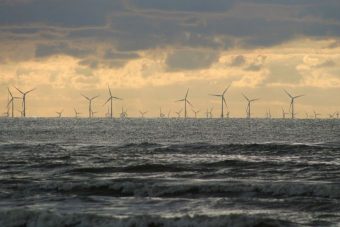
The Norwegian oil firm Statoil confirmed years ago its final investment decision to develop what is now the “world’s first” floating wind energy project — the Hywind wind farm pilot park offshore Peterhead in Aberdeenshire (Scotland).
The investment is about NOK 2 billion in total — which, according to the company, represents a 60% to 70% comparative cost reduction (per MW capacity) from the demo project in Norway. Masdar, a company CleanTechnica readers must know well, is also an investor in the project.
The 30 megawatt (MW) wind energy project on floating structures around 25 kilometers offshore of Peterhead, at “Buchan Deep,” is now operational. Will it bring floating wind farms into the future in a big way? “The closely watched project is regarded as the tipping point between pilot-scale R&D projects and full commercialization,” Tina Casey wrote here on CleanTechnica last week. But the big question is whether floating wind can scale up and see costs come down like we saw for onshore wind and non-floating offshore wind (which has gotten really cheap, surprisingly cheap, in recent years).
The Hywind project covers an area of ~4 kilometers, at a depth of around 95–120 meters. The average wind speed in this area is around 10 meters per second. Are these the ideal conditions for floating wind? If not, what are?
Scotland’s Deputy First Minister John Swinney commented in 2015: “Hywind is a hugely exciting project — in terms of electricity generation and technology innovation — and it’s a real testament to our energy sector expertise and skilled workforce that Statoil chose Scotland for the world’s largest floating wind farm.
“The momentum is building around the potential for floating offshore wind technology to unlock deeper water sites. The ability to leverage existing infrastructure and supply chain capabilities from the offshore oil and gas industry create the ideal conditions to position Scotland as a world leader in floating wind technology.”
Operation and maintenance for the project will be based out of nearby Peterhead, though also reliant to some degree on Statoil’s office in Aberdeen.
This news is interesting as well because, while offshore wind energy development has been coming along fairly well in the region, such projects are generally restricted to water depths of only 20 to 50 meters. The allure of floating wind energy projects is that, although they are more expensive, they can be located further from shore and in areas with higher potential wind energy resources. Scotland is already a wind energy giant, but it could become a much bigger giant if floating wind energy takes off.
We started covering Hywind in 2009. I imagine we’ll have plenty more updates on the project and this niche segment of the industry in the next 8 years as well.
Source: cleantechnica.com



